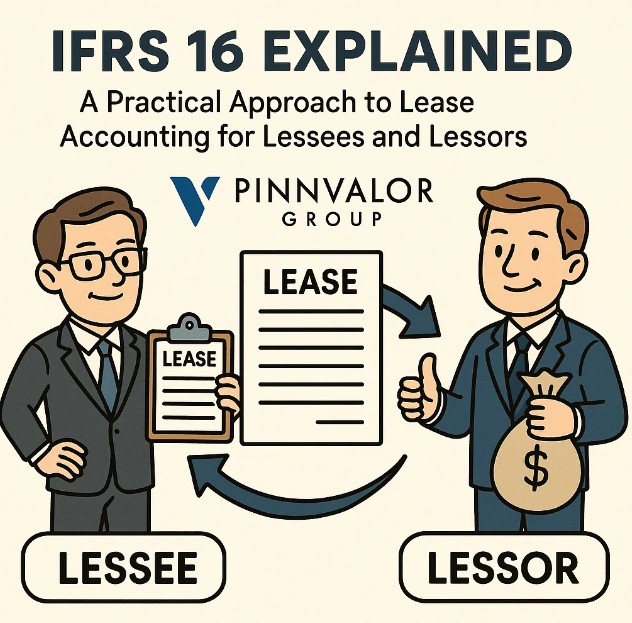
IFRS 16: A Practical Approach to Lease Accounting for Lessees and Lessors
In a business environment increasingly driven by transparency and comparability, IFRS 16 – Leases stands as a landmark accounting standard that reshapes how leases are reported in financial statements. Replacing IAS 17, IFRS 16 introduces a unified lease accounting model that enhances the visibility of lease obligations, particularly for lessees, by bringing most leases onto the balance sheet.
This blog provides a practical guide to understanding and implementing IFRS 16, covering key concepts, accounting treatment for lessees and lessors, and real-world implications.
Are you fully prepared to unlock the true financial impact of your leases with IFRS 16?
Lease liabilities are no longer hidden—IFRS 16 shines a light on your true financial obligations. Adopting best practices and technology can make the transition smoother and empower better decision-making.
🔍 What is IFRS 16?
IFRS 16, issued by the International Accounting Standards Board (IASB), became effective from 1 January 2019. Its core objective is to ensure that companies transparently reflect lease obligations on the balance sheet, promoting better comparability and financial clarity.
The biggest change introduced by IFRS 16 is for lessees, who are now required to recognize most leases as:
- A Right-of-Use (ROU) asset
- A corresponding lease liability
👥 Who Does IFRS 16 Apply To?
- Lessees: Required to apply a single accounting model for almost all leases.
- Lessors: Continue to classify leases as finance or operating leases, largely following the approach in IAS 17.
📘 Key Definitions under IFRS 16
| Term | Definition |
|---|---|
| Lease | A contract that conveys the right to control the use of an identified asset for a period of time in exchange for consideration. |
| Right-of-Use Asset | An asset that represents a lessee’s right to use the leased asset during the lease term. |
| Lease Liability | The obligation to make lease payments, measured at the present value of lease payments. |
🧾 Accounting for Lessees: The On-Balance Sheet Model
Under IFRS 16, lessees follow a single accounting model:
➤ Initial Recognition
- ROU Asset and Lease Liability are recognized at the lease commencement date.
- Lease Liability = Present value of lease payments.
- ROU Asset = Lease liability + initial direct costs + prepaid lease payments - lease incentives received.
➤ Subsequent Measurement
- Lease Liability: Increases with interest expense, decreases with lease payments.
- ROU Asset: Depreciated over the lease term or useful life (whichever is shorter).
➤ Exemptions (Optional)
Lessees can choose not to apply IFRS 16 to:
- Short-term leases (≤ 12 months)
- Low-value leases (e.g., tablets, small office equipment)
These can be recognized as straight-line expenses over the lease term.
🏢 Accounting for Lessors: Finance vs. Operating Leases
Unlike lessees, lessors continue to use the dual model:
✔ Finance Lease
- Transfers substantially all risks and rewards.
- Derecognize the asset and recognize a net investment in lease.
- Recognize interest income over time.
✔ Operating Lease
- Lease income is recognized on a straight-line basis over the lease term.
- Underlying asset remains on the lessor’s balance sheet.
📊 Impact on Financial Statements
| Aspect | Before IFRS 16 (IAS 17) | After IFRS 16 |
|---|---|---|
| Balance Sheet (Lessees) | Off-balance sheet for operating leases | Most leases on balance sheet |
| Income Statement | Lease expense (straight-line) | Depreciation + Interest |
| Cash Flow Statement | Operating cash flow affected | Lease payments split: principal (financing), interest (operating or financing) |

🧩 Practical Challenges in Implementation
Implementing IFRS 16 can be complex. Key challenges include:
- Identifying all leases embedded in contracts
- Data collection from various departments
- System changes to track lease assets and liabilities
- Judgement areas, such as determining lease term and discount rate
🛠️ Best Practices for Smooth Adoption
- Start Early: Ensure sufficient time for contract review and data gathering.
- Cross-Functional Teams: Include finance, legal, procurement, and IT in the implementation.
- Lease Management Software: Helps in automating calculations and maintaining audit trails.
- Employee Training: Equip staff with knowledge to recognize leases correctly.
- Continuous Monitoring: Leases can be modified, extended, or terminated—requiring ongoing evaluation.
🧮 Illustrative Example for Lessee Accounting
Company X enters a 5-year lease for office space. Annual payments are ₹1,00,000, and the interest rate is 6%.
- Lease Liability (PV of 5 annual payments at 6%): ~₹4,21,236
- ROU Asset: ₹4,21,236
- Each year:
- Interest expense (on liability)
- Depreciation (ROU asset over 5 years)
🔚 Conclusion
IFRS 16 has transformed lease accounting by improving transparency and comparability across entities and industries. While the shift presents operational and technical challenges, it also provides greater insight into a company’s capital commitments.
For finance professionals, adapting to IFRS 16 is not just a compliance exercise—it’s an opportunity to enhance strategic decision-making through better lease management and financial reporting.
✍️ Want to Go Deeper?
Stay tuned for our next blog where we’ll explore:
- “How to Automate IFRS 16 Lease Accounting with Technology”
- “IFRS 16 vs ASC 842: Key Differences Between IFRS and US GAAP”
